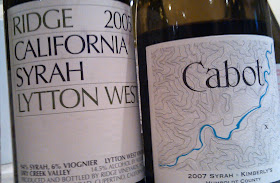It
was also my girlfriend’s birthday Sunday night. We were excited about DC being
shut down (no work!) so I took my time and I cooked us up some a nice dinner: a
salad with dried cranberries and candied walnuts followed by baked salmon
served with cauliflower puree topped with melted parmesan cheese.
I
opened a 2006 pinoit noir from Londer called Paraboll. The grapes are sourced
from Ferrington and Valley Foothills vineyards in Mendocino County’s Anderson
Valley, one of my favorite places for pinot noir in California.
 According to the winery, “The derivation
of the name is ‘para’ which is an art classification for a deep cherry-red
color and ‘boll’ which is boontling for great.” That’s Mendocino talk I guess.
“Wild yeast fermentation, aged 9 months in French oak barrels.”
According to the winery, “The derivation
of the name is ‘para’ which is an art classification for a deep cherry-red
color and ‘boll’ which is boontling for great.” That’s Mendocino talk I guess.
“Wild yeast fermentation, aged 9 months in French oak barrels.”
Color:
bright cherry
Aromas:
Starts off dark and deep, with cassis, pomegranate seeds, accented by a kiss of
cola.
Palate:
This pinot noir is rich but pure and pretty. Cranberry and wild strawberry
fruit lead the way to flavors of violets and rose petals. Initially, the wine
showed grippy tannins, even a bit rough, so I threw the wine into the decanter.
The flavors evolved to show fresh cherry and cassis fruit. The tannins smoothed
out a bit but the structure of this wine remained firm. Damp earth and rose petal flavors linger onto the finish,
along with a kick of pepper. There’s even a hint of mineral and iron in this
wine, which I love.
This
is not just a good California pinot noir, it’s a great one. It outperformed
some recent Kosta-Browne pinot noirs I’ve had because the Paraboll has a bit
more depth and mystique to it. This wine is at an interesting spot in its evolution, but if I
had another I’d lay it down for another two-to-four years to see what time will
do to this beauty.
93
points. And I’d go 100 points on the food, but I may be biased.
 Monday afternoon I opened a 1998 Château Belle-Vue from the Bordeaux appellation of Haut-Médoc.
Monday afternoon I opened a 1998 Château Belle-Vue from the Bordeaux appellation of Haut-Médoc.
Color: prune-purple with tawny rims.
Nose: initially quite dense, and it’s clear from first sniff that this wine is still alive and well. Plums and currant fruit aromas blend with moss and wet leaves. Sweet barbeque and soy sauce aromas came out with time. Basically an awesome aromatic situation. Aromas like this make me realize I'm not drinking Bordeaux frequently enough.
On the palate: coffee grind tannins and medium+ acid. Fig and currant fruit flavors are matched by coffee, potting soil and mineral. Tobacco leaf and soy linger on the finish. Still going strong, and quite balanced. Some olive brine and pickle juice add a tangy finish. This is a really impressive effort from a petite chateau. It has the structure to age for another few years, or at least this bottle did.A blend of 50% cabernet, 40% merlot and 10% petit verdot, aged for 16 months in 80% new Hungarian oak. Time has really mellowed out the oak flavors and I was surprised at the amount of new oak in this wine.
88 points
Wines like these help ease the worry that a tree will come crashing through my front window. I hope all my fellow East Coasters are hunkered down with some good wine on hand. Be safe and drink well!
 Monday afternoon I opened a 1998 Château Belle-Vue from the Bordeaux appellation of Haut-Médoc.
Monday afternoon I opened a 1998 Château Belle-Vue from the Bordeaux appellation of Haut-Médoc. Color: prune-purple with tawny rims.
Nose: initially quite dense, and it’s clear from first sniff that this wine is still alive and well. Plums and currant fruit aromas blend with moss and wet leaves. Sweet barbeque and soy sauce aromas came out with time. Basically an awesome aromatic situation. Aromas like this make me realize I'm not drinking Bordeaux frequently enough.
On the palate: coffee grind tannins and medium+ acid. Fig and currant fruit flavors are matched by coffee, potting soil and mineral. Tobacco leaf and soy linger on the finish. Still going strong, and quite balanced. Some olive brine and pickle juice add a tangy finish. This is a really impressive effort from a petite chateau. It has the structure to age for another few years, or at least this bottle did.A blend of 50% cabernet, 40% merlot and 10% petit verdot, aged for 16 months in 80% new Hungarian oak. Time has really mellowed out the oak flavors and I was surprised at the amount of new oak in this wine.
88 points
Wines like these help ease the worry that a tree will come crashing through my front window. I hope all my fellow East Coasters are hunkered down with some good wine on hand. Be safe and drink well!















